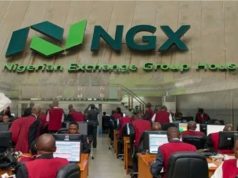SAT, MAY 30 2020-theG&BJournal- The Nigerian equities market posted another positive performance in the week, as activities seem to be normalizing post-lockdown.
The ASI recorded a gain of 0.3% w/w to bring the YTD return to -5.9%, and index level to 25,267.82 points. Analysing performances by sector, the Consumer Goods (+3.0%) sector led the gainers, followed by the Banking (+2.4%) and Insurance (+0.6%) sectors. On the other hand, the Oil & Gas (-1.0%) and Industrial Goods (-1.8%) sectors recorded the weakest performance.
Analysts however continue to caution investors to trade cautiously and seek trading opportunities in only fundamentally justified stocks as the risks remain on the horizon due to a combination of the increasing number of COVID-19 cases in Nigeria and weak economic conditions.
Fixed income and money market
The overnight (OVN) rate contracted by 12.63ppts, w/w, to 3.0%. The rate started the week pressured, following Friday’s CRR debit by the CBN. However, inflows from OMO maturities (NGN319.72 billion) and FGN bond coupon payments (NGN5.63 billion) were enough to saturate the market and drive down the OVN, notwithstanding debits for Thursday’s OMO auction (NGN114.00 billion).
Barring any mop-up activity by the CBN, we expect the OVN to steady at current levels, as we expect system liquidity to remain healthy, as inflow from OMO maturities (NGN155.78 billion) come in.
Treasury bills
The Treasury bills secondary market was seemingly bullish during the week as the average yield pared moderately by 2bps to settle at 4.9%. This primarily driven by increased interest in the PMA segment of the market, which recorded a decline in yields by 5pbs to 2.1%. In the OMO segment, yields increased by 3bps to 6.1%, given the shift in focus to the auction during the week. At Wednesday’s NTB PMA, the CBN fully allotted NGN59.37 billion worth of bills – NGN20.37 billion of the 91-day, NGN19.16 billion of the 182-day and NGN19.84 billion of the 364-day – at respective stop rates of 2.45% (previously 2.50%), 2.72% (previously 2.85%), and 4.02% (previously 3.84%).
In the coming week, we expect improved demand for T-bills, given the expectation of improved system liquidity.
Bonds
Activities in the Treasury bonds secondary market were seemingly bullish during the week, leading to the average yield across instruments contracting by 30bps to close at 10.1%. While trading was tepid for most of the week with the average yield trading sideways for most of the week, there was a strong level of demand on the final trading day of the week following the reduction of the MPR to 12.5%. We adduce the increase trading activities to both this factor and the refocus of the country to foreign debt with the announcement that the country would be seeking out a further USD5 billion in borrowings from various multilateral agencies. Across the benchmark curve, yield contracted at the short (-45bps), mid (-34bps) and long (-14bps) segments as investors accumulated the MAR-2025 (-171bps), APR-2029 (-49bps) and JUL-2030 (-37bps) bonds, respectively.
We expect demand to remain strong at the start of the coming week. However, we expect this to tail off, especially if yields pare significantly over the first few trading days, as investors refocus on the primary auction in the upper week on the 17th of June when the expectation of better yields takes precedence.
Foreign Exchange
For the fourth straight week, the CBN recorded another FX reserves build up, with the country’s external balance growing by USD535.00 million WTD to USD36.40 billion. We attribute the driver of the reserve accretion to the inflow of RFI facility by the IMF, which continues to outweigh FX outflows. Nonetheless, the Naira depreciated against the USD by 0.10% w/w to NGN386.33/USD at the I&E window and by a steeper 2.2% w/w to NGN460.00/USD in the parallel market. In the Forwards market, the naira depreciated against the USD across the 1-month (-0.08% to NGN388.01/USD) and 3-month (-0.04% to NGN391.49/USD) contracts, while it appreciated across the 6-month (+0.02% to NGN396.63/USD) and 1-year (+0.06% to NGN414.75/USD), contracts.
We still hold the view that the RFI inflow will continue to provide short-term support for the FX reserves. Nonetheless, we expect the currency market to remain largely volatile, especially in the parallel as the CBN’s suspension of FX sales to BDCs continues to create a backlog of unmet FX demand.
Meanwhile, during week, the National Bureau of Statistics reported that Nigeria’s economic activities grew at a slower pace when compared to the prior quarter. Specifically, GDP grew by 1.87% y/y (Q4-19: +2.55% y/y), mostly on the account of a slower pace of growth in the oil and non-oil sectors.
The growth outturn outperformed estimate of 0.74% y/y by 113bps. For the oil sector, an 11.0% y/y growth in crude oil production to 2.07mb/d, cascaded into a 5.06% y/y growth in oil GDP (previously: 6.36% y/y).
Meanwhile, despite the resilient agriculture (+2.20 y/y) and construction (+1.69%) sectors, slower pace of growth in the service (+1.57% y/y) and manufacturing (+0.43% y/y) sectors weighed markedly on the non-oil sector (+1.55% y/y; vs. +2.26% y/y previously).
For the next few quarters, we believe the impact of COVID-19 induced economic lockdown will reflect markedly on output growth. We now look for Q2-20 GDP to contract by 2.30% y/y, mostly driven by the oil sector, which is expected to contract on lower production.
Elsewhere, having expressed explicitly in March 2020 that it has lost faith in the effectiveness of a rate cut in tackling economic growth-related problems, the Monetary Policy Committee (MPC) delivered a 100bps rate cut, while leaving all other policy parameters unchanged.
This move came as a surprise to the market (Bloomberg consensus had expected a hold). Notably, seven members voted to cut the rate by 100bps, two members voted for a 150bps rate cut, while one member elected for a 200bps rate cut. This is the first-rate cut since March 2019, and the steepest since November 2015.
The key takeaway is that the committee acknowledged that growth will slide into the negative territory in Q2-20. However, in a bid to avoid an economic recession over 2020, the MPC elected to cut rate by 100bps, signalling its resolve to sustain its accommodative policy stance, despite imminent currency and inflationary pressure.-With Cordros Research.
|twitter:@theGBJournal|email: info@govandbusinessjournal.com.ng|
Subscribe
Login
0 Comments
Oldest









